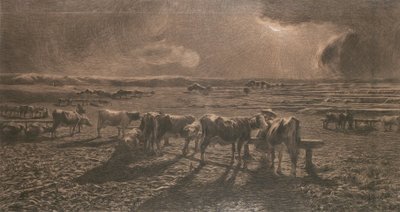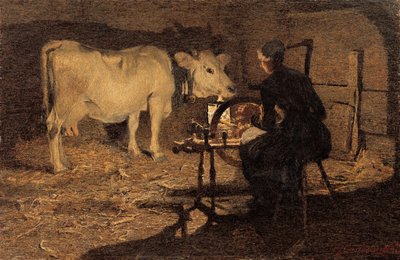"Higher and higher and more famous." I think that's the best way to describe Giovanni Segantini's life. Born in 1858 in Arco, South Tyrol, his further stations in life were higher and higher above sea level - from Milan and the Brianza, to Savognin and Maloja in the Engadine, to the Schafberg above Pontresina. The artist is regarded as a great innovator of Alpine painting.
Segantini's parents died young. At the age of seven, he came to Milan in the care of his half-sister Irene, where he later completed an apprenticeship as a shoemaker and attended the Brera Academy of Art.
With his great love Luigia Bugatti, called Bice, he left the city in 1881 and the two of them settled in the Brianza. The rural landscape helped him to return to the originality and a simple everyday life. Segantini was concerned with the lives of farmers and shepherds, which was also to be expressed in many of his paintings.
In 1886 the unmarried couple moved to the mountain farming village of Savognin in Graubünden. By this time, all four of their children were already in the world. After another eight years the family finally moved to the Engadin.
Giovanni Segantini died suddenly in 1899 at the age of 41, while he was working on his Alpine Triptych (Life - Nature - Death). He literally died at the peak of his life - the Schafberg, at an altitude of about 2700 metres, shortly after he had made his great breakthrough. Still today you can visit the Segantini hut there.
Giovanni's oldest son Gottardo, who also became a painter, wrote his father's biography. Also the Segantini Museum in St. Moritz, named after Giovanni Segantini, does not let the great artist be forgotten.
A good friend of Segantini was Carlo Bugatti, brother of Luigia and father of Ettore Bugatti, the founder of the famous car manufacturer.
×




.jpg)
.jpg)
.jpg)
.jpg)
_1886_-_(MeisterDrucke-803951).jpg)
_1886_-_(MeisterDrucke-803951).jpg)
.jpg)
.jpg)
.jpg)
.jpg)
_-_(MeisterDrucke-1120283).jpg)
_-_(MeisterDrucke-1120283).jpg)


_-_(MeisterDrucke-1110741).jpg)
_-_(MeisterDrucke-1110741).jpg)
.jpg)
.jpg)
.jpg)
.jpg)
_oil_on_canvas_54x88_cm_-_(MeisterDrucke-1119891).jpg)
_oil_on_canvas_54x88_cm_-_(MeisterDrucke-1119891).jpg)
.jpg)
.jpg)
_-_(MeisterDrucke-947785).jpg)
_-_(MeisterDrucke-947785).jpg)
.jpg)
.jpg)
.jpg)
.jpg)
.jpg)
.jpg)
_1894-1897_Sun_210_-_(MeisterDrucke-985617).jpg)
_1894-1897_Sun_210_-_(MeisterDrucke-985617).jpg)
.jpg)
.jpg)
.jpg)
.jpg)
.jpg)
.jpg)
_1888_-_(MeisterDrucke-376783).jpg)
_1888_-_(MeisterDrucke-376783).jpg)
.jpg)
.jpg)
.jpg)
.jpg)
.jpg)
.jpg)
.jpg)
.jpg)
.jpg)
.jpg)
.jpg)
.jpg)
.jpg)
.jpg)
_oil_on_canvas_-_(MeisterDrucke-1119991).jpg)
_oil_on_canvas_-_(MeisterDrucke-1119991).jpg)
.jpg)
.jpg)
.jpg)
.jpg)
.jpg)
.jpg)
_-_(MeisterDrucke-1117117).jpg)
_-_(MeisterDrucke-1117117).jpg)
.jpg)
.jpg)
.jpg)
.jpg)
.jpg)
.jpg)


.jpg)
.jpg)
_oil_on_canvas_51x75_cm_-_(MeisterDrucke-1103827).jpg)
_oil_on_canvas_51x75_cm_-_(MeisterDrucke-1103827).jpg)
.jpg)
.jpg)
.jpg)
.jpg)
.jpg)
.jpg)
_-_(MeisterDrucke-1474220).jpg)
_-_(MeisterDrucke-1474220).jpg)
.jpg)
.jpg)
.jpg)
.jpg)
.jpg)
.jpg)
 - (MeisterDrucke-192449).jpg)
 - (MeisterDrucke-192449).jpg)
.jpg)
.jpg)
_oil_on_canv_-_(MeisterDrucke-1119813).jpg)
_oil_on_canv_-_(MeisterDrucke-1119813).jpg)
.jpg)
.jpg)
_-_(MeisterDrucke-1109663).jpg)
_-_(MeisterDrucke-1109663).jpg)
.jpg)
.jpg)
.jpg)
.jpg)
.jpg)
.jpg)
.jpg)
.jpg)
.jpg)
.jpg)
.jpg)
.jpg)
.jpg)
.jpg)
_oil_on_canvas_35x26_-_(MeisterDrucke-1109194).jpg)
_oil_on_canvas_35x26_-_(MeisterDrucke-1109194).jpg)
.jpg)
.jpg)
_1894_Sun_-_(MeisterDrucke-985616).jpg)
_1894_Sun_-_(MeisterDrucke-985616).jpg)
_-_(MeisterDrucke-1103831).jpg)
_-_(MeisterDrucke-1103831).jpg)
_oil_on_canvas_88x69_cm_-_(MeisterDrucke-1117613).jpg)
_oil_on_canvas_88x69_cm_-_(MeisterDrucke-1117613).jpg)
.jpg)
.jpg)
.jpg)
.jpg)
.jpg)
.jpg)
.jpg)
.jpg)
_-_(MeisterDrucke-1117156).jpg)
_-_(MeisterDrucke-1117156).jpg)
.jpg)
.jpg)
.jpg)
.jpg)
_oil_on_canvas_-_(MeisterDrucke-1110114).jpg)
_oil_on_canvas_-_(MeisterDrucke-1110114).jpg)
.jpg)
.jpg)
.jpg)
.jpg)
.jpg)
.jpg)
.jpg)
.jpg)
.jpg)
.jpg)
.jpg)
.jpg)
_-_(MeisterDrucke-1119848).jpg)
_-_(MeisterDrucke-1119848).jpg)
.jpg)
.jpg)


.jpg)
.jpg)
.jpg)
.jpg)
.jpg)
.jpg)
.jpg)
.jpg)
_-_(MeisterDrucke-1123540).jpg)
_-_(MeisterDrucke-1123540).jpg)
.jpg)
.jpg)
_-_(MeisterDrucke-1014415).jpg)
_-_(MeisterDrucke-1014415).jpg)
.jpg)
.jpg)
.jpg)
.jpg)
.jpg)
.jpg)
.jpg)
.jpg)
.jpg)
.jpg)
.jpg)
.jpg)
_oil_on_canvas_57x110_cm_-_(MeisterDrucke-1103756).jpg)
_oil_on_canvas_57x110_cm_-_(MeisterDrucke-1103756).jpg)
.jpg)
.jpg)
.jpg)
.jpg)
.jpg)
.jpg)
.jpg)
.jpg)
.jpg)
.jpg)
.jpg)
.jpg)






